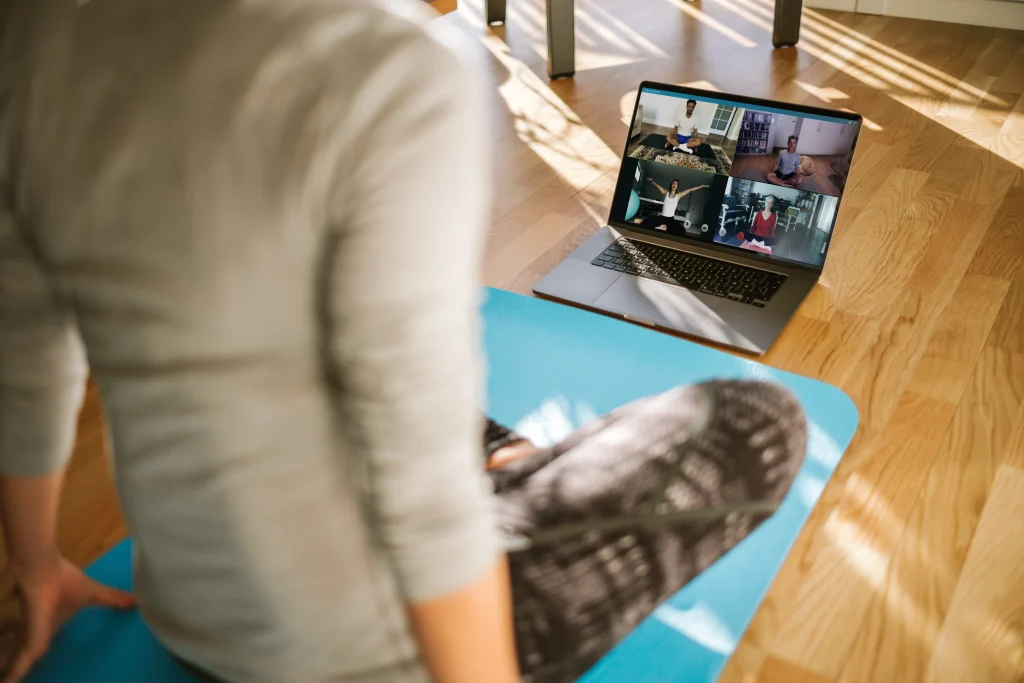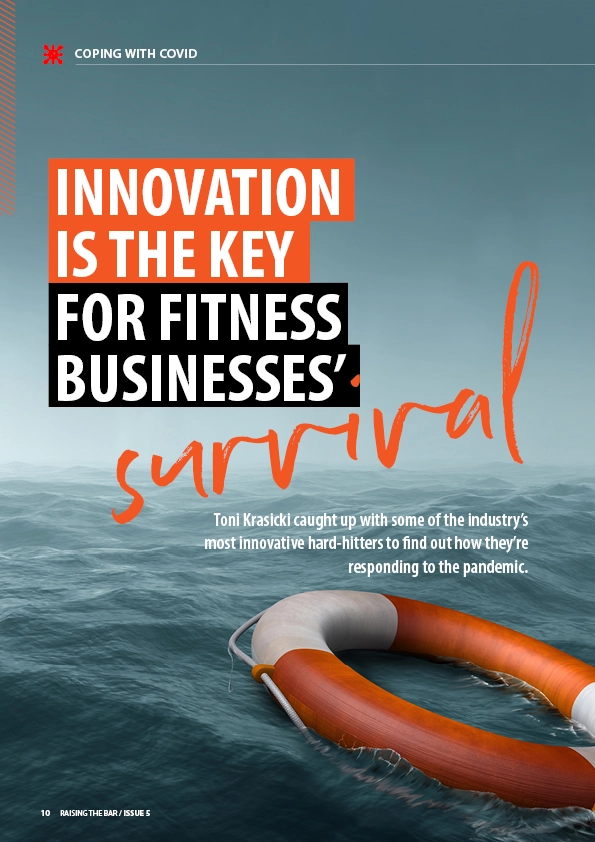COPING WITH COVID
Innovation is the Key for Fitness Businesses’ Survival

The fitness industry has always rolled with the punches. When big box gyms and health club chains muscled their way into the fitness market, it seemed like every second independent gym were fearing closing their doors in response. However, the industry fought back and delivered a new concept to satisfy the crowd who wanted less of the ‘big’ and more in the way of a specialised service. Boutique studios mushroomed, filling the gaps and offering a one-format class model. Yoga, Pilates, barre, cycle, boxing, CrossFit, personal training, flexibility/stretch, wearable fitness, you name it – there was something for everyone.
During the past decade, another curveball blindsided the industry – the budget 24/7 gyms. Accessible and affordable, these centres that represent the high volume, low cost side of the market, greatly boosted the expansion of the fitness industry. The rapid expansion of 24/7 giants Anytime Fitness, Jetts, Snap Fitness 24/7 and Plus Fitness peaked a few years ago, but their presence prompted big box gyms to rethink their own business strategies and introduce 24/7 access at their own facilities.
Until COVID-19 rattled the world causing lockdowns and loss of business, every type of fitness business had managed to find their place in the market. Although presently, Victorian gyms are struggling through a second lockdown, overall the Australian fitness industry is looking to a brighter future.
Cofounder and Event Director at Business of Fitness, Shaun Krenz believes that as an outcome of this pandemic, health and wellness will become a top priority for everyone. “For health club operators, 2020 has been hard and I have certainly felt this in my discussions of late, but the long-term future is exciting,” he says. “The most valuable currency is, in fact, health and how we feel.”
When South Australian gyms reopened, Ben Barge, Cluster Fitness Director (South Australia) and National Support for Goodlife Health Clubs, says that people began re-evaluating what was important to them. “With people not being able to go out and exercise at a gym or a park – six, seven kilometres away, it caused them to realise how important their health really is.”
As Western Australia eased restrictions in mid-May, Business Partnership Manager WA for Les Mills Asia Pacific, Lee Smith says that with physical distancing in place, fitness businesses have seen close to, if not a return to, pre-COVID numbers in the group fitness space, with generally strong membership numbers too.
“Group fitness has been shining through in many gyms, as small groups were some of the first allowed activities. Gym goers, keen to get back to connect with people again, to feel the motivation of the music and a passionate instructor, happened quickly, and although the timetables were reduced along with class numbers, the classes were busy and that started the momentum.”
Barge believes the key to retaining members, both during and after the pandemic, is communication. “Your clients are used to talking to you on a regular basis, so even if they aren’t in a position to pay you for training right now, keep chatting with them. Because the way you treat your clients right now shows who you are as a PT. By making a five-minute phone call once a week to those clients means when they’re ready or able to come back to training, they’ll come back to you. Of course, equally important for managers, is to keep communicating with their team. We need to be supporting them, training them in things like Facebook Live or Zoom and leading by tackling things head on. It’s important that they, like our clients, feel supported and connected through this time.”
Snap Fitness has had such an increase in membership sign-ups; they are set to open 10 new clubs across the country before the year is out.
However, in the US, it’s a different story. In a recent ClubIntel report (‘The Peril Promise and Reality of the Pandemic for the Fitness Industry’), it mostly reads doom and gloom. Many brick-and-mortar-based gyms and fitness studios are shutting up shop, while sales of personal fitness equipment and technology have grown at record levels, along with subscriptions for online classes and streaming fitness services.
With several big gym chains or long-term clubs filing for bankruptcy or closing many of their clubs, the US fitness industry are forecasting a loss of US$350 million a month for the remainder of the year, equating to $8 billion for 2020.
CHANGING THE WAY GYMS AND FITNESS STUDIOS ROLL
ClubIntel reports that fitness businesses that are nimble, highly fluid, digitally savvy, and prepared to think and act differently are the ones that will survive and thrive. ClubIntel is suggesting to have a competitive edge post-COVID, and to “seamlessly blend digital workouts, digital group exercise, digital events and competitions, mobile portability, AI, and XR (mixed realities) with a modified version of their brick-and-mortar experience.”
With data showing that existing clubs and studios can expect between 65 and 85 per cent of their members to return at reopening, ClubIntel says, “the fitness facility of tomorrow will have a reconstructed value proposition that allows it to be profitable and sustainable with fewer members than before the pandemic.”
CEO of Australian Fitness Network and Australian Institute of Fitness, Steve Pettit says that the industry will never look the same. Like Krenz and Barge, he agrees that the imposed restrictions have been a reminder to us all of how important our mental and physical wellbeing is, and driving the fitness industry from strength to strength. Pettit believes that there will be an increase in people willing to invest in personal trainers, with trainers using contemporary methods to reach more people. Barge adds that the trainers who are quick to adapt to restrictions are the ones coming out on top, post-lockdown.
“Never before has there been such a high uptake of virtual fitness supported by a new wave of training options,” says Pettit. “Gyms and fitness studios that have a balanced approach between onsite workouts and virtual workouts will be best placed to find the right mix for their members.”
Smith says, “COVID-19 has been the ultimate disruptor that has forced fitness businesses to look at how they operate, what they offer and even why they operate.” He has found that technology has been the big hitter here, on both a business operational level and a member level.

GOING VIRTUAL
When restrictions forced gyms and fitness studios into lockdown the industry turned to an online service delivery model literally overnight. Smith says, “technology has always been growing within the fitness space, both at an operational level, on the gym floors and within the studios, BUT it has now accelerated and the slowing linear growth has just seen the trending graph line shoot straight up!” With over 1,000 LES MILLS™ workouts available to download, many gyms have become Affiliate Partners for LES MILLS™ On Demand, driving subscribers up by the thousands. In addition to this, our Club Partners now also have the opportunity to live-stream LES MILLS workouts to their members, which is also proving another game-changer for those clubs.
National Fitness Manager, Genesis Health + Fitness, Coaching Zone and Home Fitness Network, Sam Merza says that they moved quickly when the COVID closure announcement came through. Over four days, a group of health and fitness experts across the business developed Home Fitness Network, an online health, fitness and wellness platform, to allow members to keep physically and mentally fit, from home.
“One of the offerings within Home Fitness Network, is live online group fitness sessions, hosted by our own fitness coaches and personal trainers,” he said. “Allowing our fitness professionals to continue to operate in a virtual environment really empowered them to keep doing what they love to do most.”
Powerliving Yoga Studio Manager in Sydney, Fiona Scicluna says that Powerliving have successfully taken their classes, workshops and teacher trainings online. “We now offer both in-studio classes, Livestream classes and yoga-on-demand via yogaholics, and our two 200hr teacher training programs can be taken either online or in person.”
She says that the online products have proven successful, with some students preferring the online service, whilst others loving the options. “With the changing circumstances across the globe, this has allowed our products to be more accessible to our students.” She admits that it’s been a huge learning curve, learning to connect with students digitally, whilst at the same time still offering an exceptional customer experience.
While gyms and fitness studios have been forced to transform the way they do business, so too have businesses delivering industry education. The Australian Institute of Fitness (The Institute), have had to temporarily alter their business model to incorporate virtual face-to-face industry education. Although challenging, they quickly transformed their educational material and launched a cutting-edge solution. “Our face-to-face students quickly needed to adapt to an online mode of learning and we were very appreciative of their understanding and support,” says Pettit. “The other major change was moving to a work from home model,” he adds. “It’s given us the opportunity to consider what the best combination of working from home versus on campus will be when restrictions fully ease.”
Like some gyms and fitness studios, The Institute have been able to swing to a full online business. “It has given us the opportunity to reassess our strategy and ensure we are offering a balanced mix of online and face-to-face education,” says Pettit. “We have also had the ability to engage our expert coaches on some special projects with less on-campus delivery.” During the lockdown The Institute and Network ran the ‘Upskill During Downtime’ campaign, and offered free online education to fitness professionals.
THE FUTURE
It’s been three months since Western Australian gyms opened their doors; but some businesses are still looking at fitness options in the instance there is another lockdown.
“There is a ‘new normal’ in place and the most common questions I’m getting from club owners and managers is in regards to virtual fitness,” explains Smith. The technology-based in-gym offering uses a big screen and a platform that can be set to offer high quality pre-recorded, virtual classes where a new class can run every 30, 45 or 60 minutes. “The thinking is, that with physical distancing in place, more classes with less people and more often would be a way to combat another disruption, should it come at us again. The investment is small compared to being forced to shut completely.”
Barge says, “It’s all about adapting and changing with the times and keeping that passionate energy up. So even though it is bleak for a lot of places right now, particularly in Victoria, there is a light at the end of the tunnel.” ®
REFERENCES
Australian Institute of Fitness
24/7 information
ClubIntel Report
The Peril Promise and Reality of the Pandemic for the Fitness


Toni Krasicki
A freelance health, fitness and travel writer with 30 years’ experience in the industry, Toni has a Bachelor’s degree in Human Movement Science and a Post Graduate Diploma in Health Promotion. Currently teaching aqua, Toni can be contacted at [email protected]